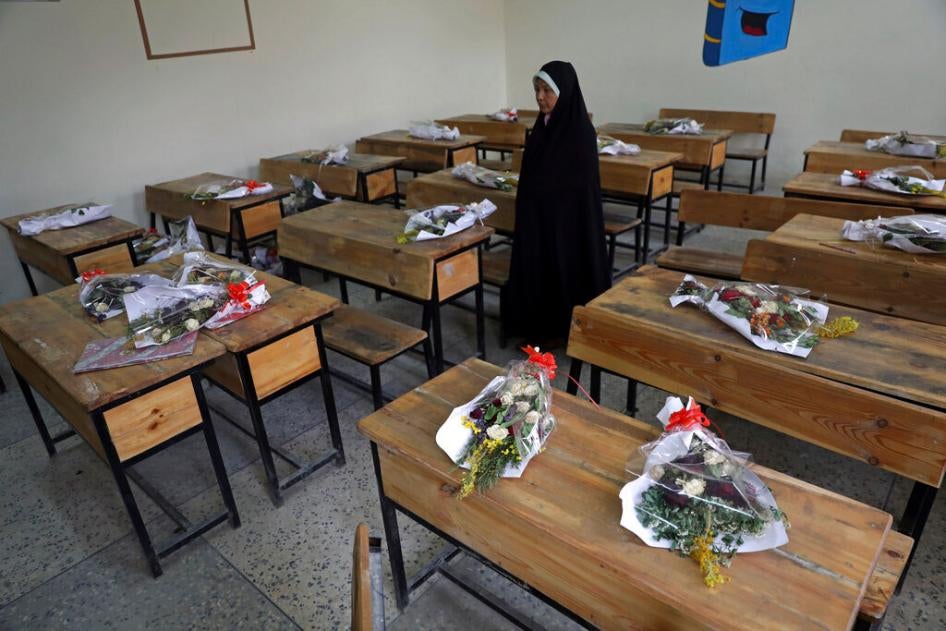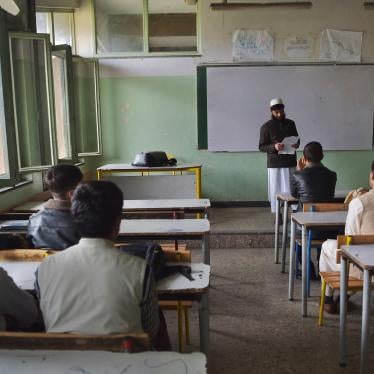(New York) – Explosive weapons were used to attack about 40 schools in Afghanistan during the first six months of 2021, as Taliban forces took over key territories, the Global Coalition to Protect Education from Attack (GCPEA) said in a report released today. Most of the 185 students and teachers killed or wounded in these attacks were girls and women. The report was released ahead of the second United Nations International Day to Protect Education from Attack, on September 9, 2021.
The 15-page report, “The Impacts of Explosive Weapons on Education: A Case Study of Afghanistan,” identified more than 200 such attacks on Afghan students, teachers, schools, and universities between 2018 and mid-2021. The attacks included airstrikes, shelling, and use of improvised explosive devices. Over 600 educators and students were reportedly injured or killed in these attacks, and more than 70 schools were reportedly damaged. Explosive weapons were used in an increasing proportion of all attacks on schools since 2018; other attacks included arson, raids, and small arms fire.
“The alarming developments in Afghanistan show the urgent need to keep schools safe and operating,” said Diya Nijhowne, executive director of GCPEA. “Armed forces and non-state armed groups should avoid using explosive weapons with wide-area effects in populated areas, including near schools or universities or along routes to or from them. Curtailing use of explosives would protect not only students, teachers, and education facilities but all civilians.”
Non-state armed groups used explosive weapons to target girls’ education in Afghanistan at least twice a year between 2018 and mid-2021, reportedly killing or injuring at least 160 female students and education personnel and damaging or destroying at least five girls’ schools.
Explosive weapons that produce wide-area effects are particularly dangerous when used in heavily populated areas. They produce a large blast, can spread fragments over a wide radius, and many are so inaccurate that they cannot be effectively targeted and can indiscriminately harm civilians.
Like other attacks on education, attacks using explosive weapons have indirect impacts beyond casualties and destruction. Students miss weeks or months of class, and fear and trauma interfere with learning when they return. GCPEA identified reports of attacks on education involving explosive weapons in at least 20 countries in 2020 and 2021.
The attacks in Afghanistan coincide with an alarming increase in attacks on education globally. The coalition identified more than 2,400 attacks on education facilities, students, and educators in 2020, a 33 percent increase over 2019. Attacks continued in startling numbers in 2021. In Myanmar, for example, over 100 attacks on schools occurred in May alone, many involving explosive weapons. And in Colombia, attacks and the use of explosive weapons hindered access to schools, including for Indigenous children.
The Safe Schools Declaration, a political commitment to protect students, educators, schools, and universities in armed conflict, endorsed by 111 countries to date, plays an essential role in preventing and mitigating the impact of attacks on education. By endorsing the declaration, countries commit to take concrete steps to protect education in armed conflict, including by using the Guidelines for Protecting Schools and Universities from Military Use during Armed Conflict. Since 2015, over a dozen countries have made changes to their national policies and practices, including their military manuals, to limit use of schools for military purposes.
The declaration also includes a commitment to strengthen monitoring and reporting of attacks on education. The coalition recently released the Toolkit for Collecting and Analyzing Data on Attacks on Education, which provides concrete guidance to governments and their partners on gathering and reporting data on attacks on education, including attacks involving explosive weapons, so that their impact can be better understood and more effective prevention and response measures developed.
Nigeria will host the Fourth International Conference on the Safe Schools Declaration on October 25-27, in collaboration with the African Union Commission, Argentina, Norway, Spain, and GCPEA. The conference will provide a key opportunity to share good practices in keeping education safe during armed conflict, and moving from commitment to practice, the theme of the Conference. All countries are invited to participate.
“The second UN International Day to Protect Education from Attack is a crucial moment to remind the world of the harm, death, and destruction attacks on education, particularly explosive weapons, have caused students and educators, schools and universities, in Afghanistan and beyond,” said Nijhowne. “The Safe Schools Declaration is a comprehensive framework for protecting education and coordinated, targeted, and sustainable support for it will save lives and better enable students to realize their right to education globally.”








